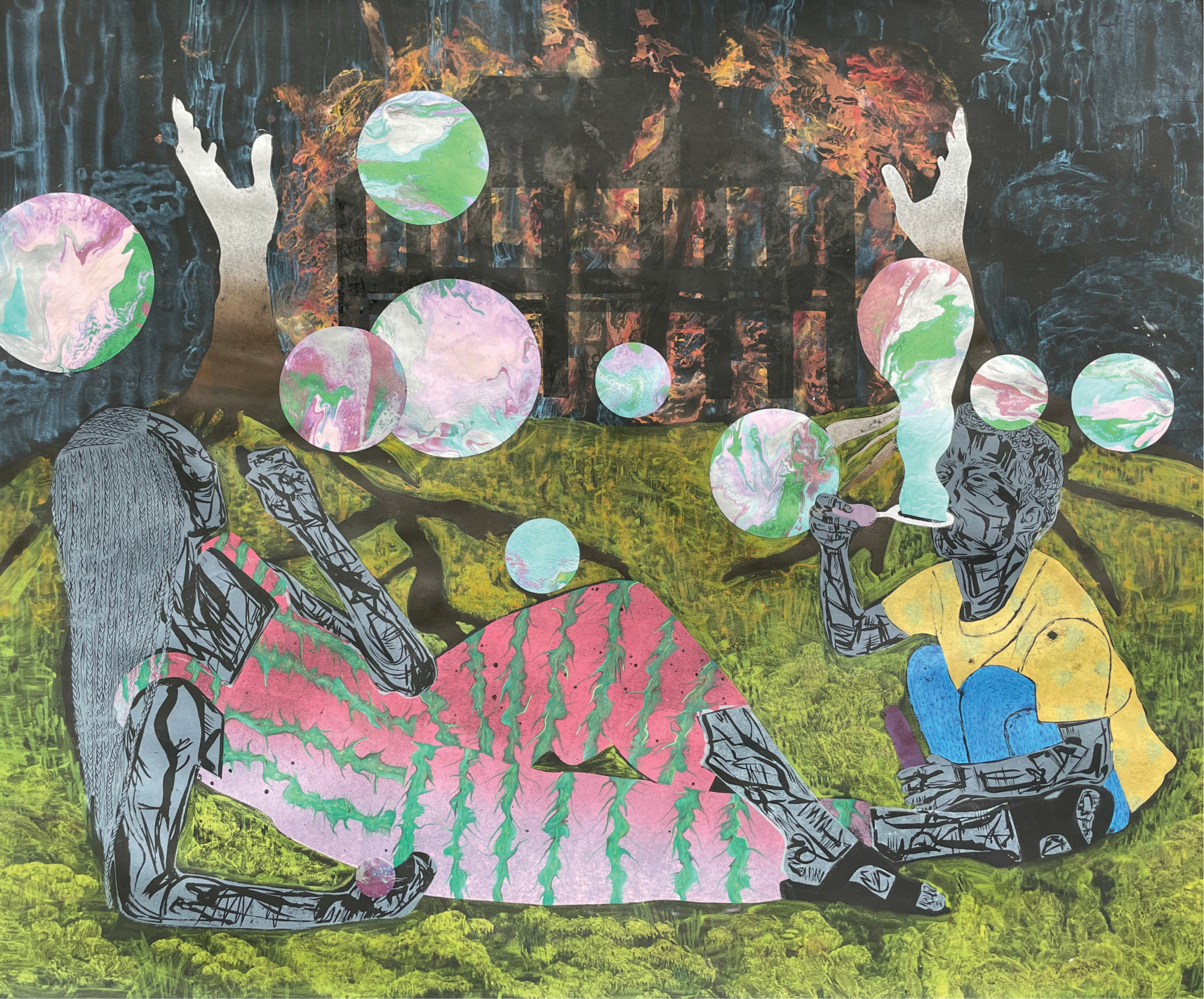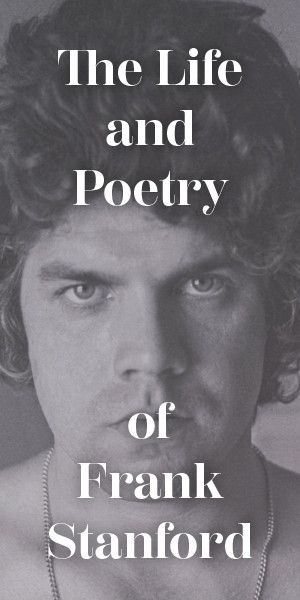
In the Field of Simple Childhood Pleasures and Burning Houses, 2023, monotype, linocut, collage, and oil pastel, by Katrina Andry. Courtesy the artist and Marc Straus
What If It All Burned Down?
By Katrina Andry
To be fair, my curiosity had brimmed before the man from France contacted me out of the blue, claiming to be a blood relative. I’d looked him up, convinced someone was trying to scam me in some way. We met in New Orleans at a divey wine bar, while he was here on a quest to understand his ancestors’ slave-owning past and their lives in south Louisiana, on what was once called the “German Coast.” At the time, he didn’t understand that enslaved people had the same last names as their enslavers.
It had even started before I was invited to an affair at the home in which Jefferson Davis, the president of the failed Confederacy, spent his final days. A home couched neatly within the Lower Garden District neighborhood of New Orleans, next to other stately mansions on Camp Street. The only thing setting it apart from its neighbors: a plaque staked in the front lawn, stating its historical significance. The only thought running through my head was how much I wanted to burn the place down.
It might have begun decades ago, during my high school years in the late ’90s, when I’d visited the main library in New Orleans on Loyola Ave., near City Hall. On the third or fourth floor, where the special collections are kept, I’d stumbled upon a book encased in glass: a ledger of people who’d been enslaved at the Andry Plantation. In the early 1800s it was one of the largest plantations in the area, spanning from Lake Pontchartrain to the Mississippi River. What’s left of the plantation, the “big house,” is now an unassuming pale blue home in a LaPlace neighborhood, about forty-five minutes outside of New Orleans. It was the first time I’d wondered about the last name that was given to my ancestors, passed on to me. I’d also wondered what made this ledger so significant that it was encased in glass and on display. Years later, when I had just moved back to Louisiana for grad school around 2008, I was invited to an exhibition and festival at the Destrehan Plantation along River Road, about a half hour outside of New Orleans, where on display was artwork reenacting the largest slave revolt in U.S. history; the numbers vary between 150 and 500 revolutionaries. The friend who’d invited me thought I’d be especially interested given that the revolt began at the Andry Plantation. Again, my surname, given to me, inherited, haunting me. And even then, I’d felt the overwhelming urge to burn the plantation down.
That was when I learned that part of the revolutionaries’ plan, as they marched toward New Orleans in 1811 to declare all people free, was to burn down every plantation they passed along the way. Places they helped build, edifices of their torment and perpetual enslavement. I believe the urge that I feel is a trait, passed through the generations to me from my ancestors who may have participated in the revolt. It was during this time that a seed was planted in me and I first felt a real connection to this place, time, and series of events. And as people tend to do, I began to imagine “what if?” Revising history in my mind, visualizing that the revolt had been successful.
The revolt was so carefully planned that it was enacted during the time it had the best possible chance to succeed. Officials in New Orleans were preoccupied with the conflict that would be known as the War of 1812. The successful Haitian Revolution had taken place not long before, and many plantation owners concerned with continuing their practice of enslavement and extraction had moved to French-speaking southern Louisiana. Their enslaved captives, inspired by the successful revolt, had freedom and revolution on their minds. The small group, led by Charles Deslondes, began at Andry and grew to an estimated five hundred people as they marched along River Road, gathering power and momentum over twenty-two miles. Unfortunately, the revolt wasn’t successful: A militia killed Deslondes; the other revolutionaries were placed on trial and executed. But what if they had been successful?
Since high school, again and again, my last name has pulled me into the story of the 1811 Revolt. Folks assume I have an ancestral connection to the time, to the place, and even to the urge to burn it down. I started to feel it too. And while it’s immensely difficult for most Black people in the diaspora to trace their ancestry, due to enslavement and forced migration, a last name still pulls a person into a feeling of connection. I found myself wondering about the lives and circumstances of the people who lived on the Andry Plantation and what propelled them to fight for their freedom. If they had burned down every plantation from LaPlace to New Orleans along River Road, what would that have meant for current residents of New Orleans? What would it mean for my Andry family? For my children? How much more joy, autonomy, freedom of movement and expression, and enhanced quality of life would they have experienced? What would it mean if these plantations, where people now get married and throw parties, where stories of “soft slavery” and “the good slave life” and “the hard-working master” are told, no longer existed? What would that do to the psyches of those Americans who claim these places are part of their heritage, perpetuating lies and essentially erasing the slave narrative, replacing it with tales of “beautiful, happy homes” and myths of northern aggression? All of these questions and scenarios swirled in my head and seeded in me a more intense feeling of wanting to erase these antebellum houses of horror.
During the summer of 2020, I began photographing some of the plantations along River Road between New Orleans and LaPlace for reference, and then went beyond daydreaming and started to render images of these homes on fire. I used color reduction woodcut, which destroys the wood in the process of creating the image, and then incorporated monotype and collage. I started the series by depicting my twins as having started the fire, joyously and triumphantly running toward the viewer, and, in another image, in the midst of experiencing a simple pleasure, like blowing bubbles. The body of work I created in connection to the 1811 Revolt and my ancestral ties is a presentation of the past and present, reimagining them both in one image. In the background of all the works, plantations are on fire. In the foreground, my family members are committing small acts of joy, or despondent southerners are anguished over losing an institution where they can perpetuate white supremacy veiled as proud displays of Southern heritage.
While this work was first shown in New York City with MARC STRAUS gallery, it was important that I was able to bring it back to New Orleans, so close to where the actual revolt occurred, for a showing at IBIS Contemporary Art Gallery in the fall of 2023. I hope to inspire folks to imagine what was in the hearts and minds of those who attempted to free themselves and others on that night, as well as to see what these sites of such atrocities could be if we faced the truth. Facing that truth could lead to greater unity and joy. Empathy is the conduit, a chance to see others’ full humanity, grasp it, wear it, and feel closer to them.





